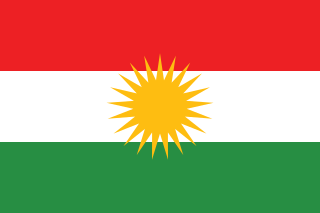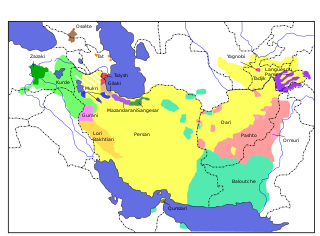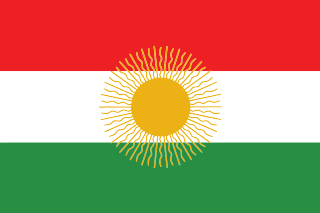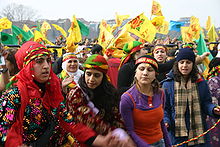
Kurds or Kurdish people are an Iranic ethnic group native to the mountainous region of Kurdistan in Western Asia, which spans southeastern Turkey, northwestern Iran, northern Iraq, and northern Syria. There are exclaves of Kurds in Central Anatolia, Khorasan, and the Caucasus, as well as significant Kurdish diaspora communities in the cities of western Turkey and Western Europe. The Kurdish population is estimated to be between 30 and 45 million.

Kurdistan, or Greater Kurdistan, is a roughly defined geo-cultural region in West Asia wherein the Kurds form a prominent majority population and the Kurdish culture, languages, and national identity have historically been based. Geographically, Kurdistan roughly encompasses the northwestern Zagros and the eastern Taurus mountain ranges.

Diyarbakır, formerly Diyarbekir, is the largest Kurdish-majority city in Turkey. It is the administrative center of Diyarbakır Province.

Newroz or Nawroz is the Kurdish celebration of Nowruz; the arrival of spring and new year in Kurdish culture. The lighting of the fires at the beginning of the evening of March 20 is the main symbol of Newroz among the Kurds.

The Zazas are a people in eastern Turkey who traditionally speak the Zaza language, a western Iranian language written in the Latin script. Their heartland consists of Tunceli and Bingöl provinces and parts of Elazığ, Erzincan and Diyarbakır provinces. Zazas generally consider themselves Kurds, and are often described as Zaza Kurds by scholars.

Xoybûn or Khoyboun was a Kurdish nationalist political party, that is known for leading the Ararat rebellion, commanded by Ihsan Nuri. Many Armenians joined the movement as well, the party was active in all parts of Kurdistan until it was dissolved in 1946.

Kurdistan was the first Kurdish newspaper. It was first published on April 22, 1898 in Cairo, Egypt by Mikdad Midhad Bedir Khan, a member of the Kürdistan Teali Cemiyeti. In four years, 31 issues were printed in cities as Cairo, Geneva, London and Folkestone. It was an opposition newspaper published in exile and supported by the Committee of Union and Progress and was published in Constantinople after the Young Turk revolution in 1908. It was often printed at CUP linked print shops which caused the newspaper to move to where ever the CUP had to establish itself anew due to the CUP's persecution by Ottoman ambassadors loyal to Sultan Abdülhamid.

The Kurdish population is estimated to be between 30 and 45 million. Most Kurdish people live in Kurdistan, which today is split between Iranian Kurdistan, Iraqi Kurdistan, Turkish Kurdistan, and Syrian Kurdistan.

Turkish Kurdistan or Northern Kurdistan is the southeastern part of Turkey where Kurds form the predominant ethnic group. The Kurdish Institute of Paris estimates that there are 20 million Kurds living in Turkey, the majority of them in the southeast.

The Kurds are the largest ethnic minority in Turkey. According to various estimates, they compose between 15% and 20% of the population of Turkey. There are Kurds living in various provinces of Turkey, but they are primarily concentrated in the east and southeast of the country within the region viewed by Kurds as Turkish Kurdistan.

The Koçgiri rebellion was a Kurdish uprising, that began in the overwhelmingly militant Koçgiri region in present-day eastern Sivas Province in February 1921. The rebellion was initially Alevi, but it succeeded in gathering support from nearby Sunni tribes. The tribal leaders had a close relationship with the Society for the Rise of Kurdistan (SAK). The rebellion was defeated in June 1921.

Mehmed Şerif Pasha, a founding member of Kurd Society for Cooperation and Progress and representative of the Society for the Elevation of Kurdistan to the Paris Peace Conference (1919–1920). He was a leading Kurdish nationalist.

The Sheikh Said rebellion was a Kurdish nationalist rebellion in Turkish Kurdistan in 1925 led by Sheikh Said and with support of the Azadî against the newly-founded Turkish Republic. The rebellion was mostly led by Zaza speakers, but also gained support among some of the neighboring Kurmanji-speaking Kurds in the region.

Esenyurt, formerly known as Ksenos, is a municipality and district of Istanbul Province, Turkey. Its area is 43 km2, and its population is 983,571 (2022). Located in the European side of Istanbul, Esenyurt borders with Avcılar and Lake Küçükçekmece on the east, Büyükçekmece on the west, Başakşehir, Arnavutköy and TEM road on the north and Beylikdüzü and E-5 motorway on the south.
Society for the Rise of Kurdistan also known as the Society for the Advancement of Kurdistan (SAK), was secretly established in Constantinople on 6 November 1917 and officially announced organization formed on the 17 December 1918. It was headquartered in Istanbul, with the aim of creating an independent Kurdish state in eastern Turkey. The Society based its statements for an independent or autonomous Kurdistan on the Treaty of Sèvres and the Fourteen Points stipulated by Woodrow Wilson. The society formed many local dependencies in the eastern provinces of Turkey.

Kamuran Ali Bedirxan was a Kurdish politician, lawyer and writer.

During World War I, several Kurdish rebellions took place within the Ottoman Empire.

Kurdistan Eyalet was an eyalet of the Ottoman Empire. It was the first time that the Ottoman Empire used the term "Kurdistan" to refer to an administrative unit rather than a geographical region. It was formed with the aim of establishing direct control over Kurdistan, rather than recognizing it as a political entity.

Mevlanzade Rifat Bey, was an Ottoman Kurdish journalist and poet.

Ottoman Kurdistan refers to areas of Kurdistan which were part of the Ottoman Empire. During the Ottoman Empire's peak they controlled all of modern-day Turkish Kurdistan, Iraqi Kurdistan, and Syrian Kurdistan, as well as a small part of Iranian Kurdistan. The term "Kurdistan" was used regularly by Ottoman officials to refer to its regions where Kurds made up a majority, and was included on many maps.


















